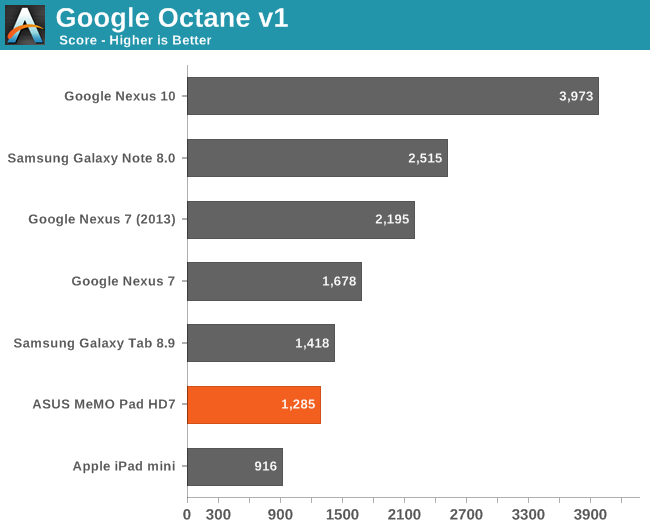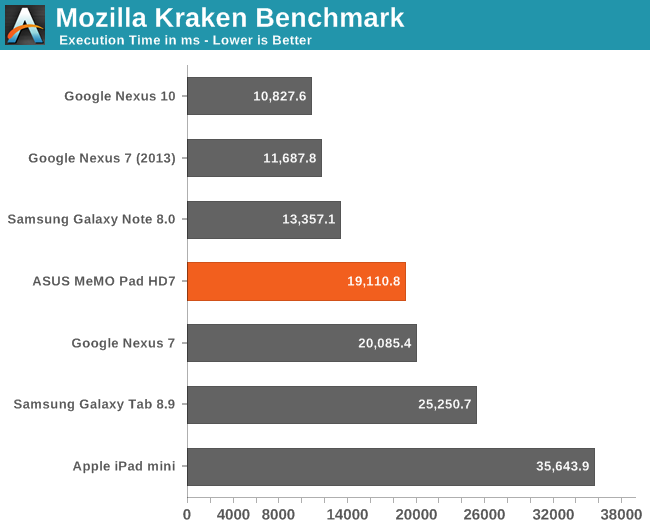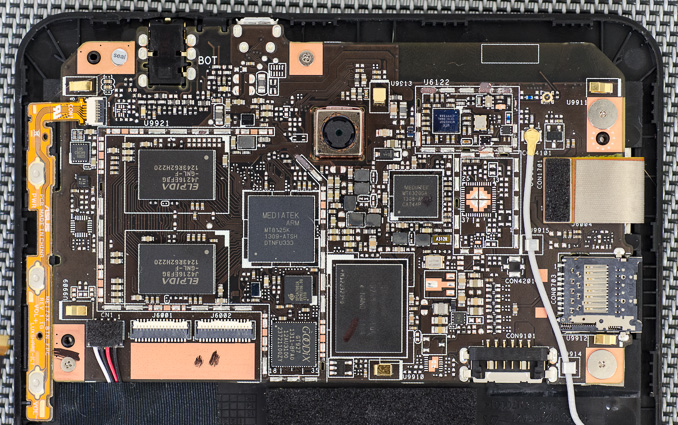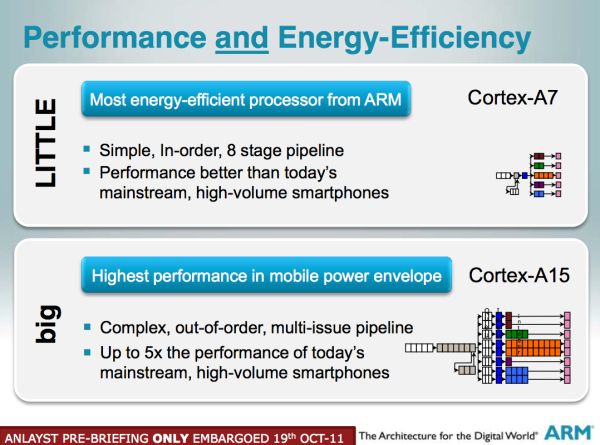ASUS MeMO Pad HD7 Review: $149 Nexus 7.1 Successor & Our First Look at MediaTek's MT8125
by Anand Lal Shimpi on July 29, 2013 3:55 PM EST- Posted in
- Tablets
- Asus
- Mobile
- Android 4.2
- MeMO Pad
MediaTek MT8125 Inside
To hit its $129/$149 price point, ASUS outfitted the MeMO Pad HD7 with a quad-core Cortex A7 based SoC from MediaTek: the MT8125. Before we get to the specifics of this SoC, it's important to put MediaTek in perspective since this is the first time we've ever reviewed one of its SoCs.
In our SoC coverage at AnandTech we tend to focus on the big five: Apple, Intel, NVIDIA, Qualcomm and Samsung. TI dropped out of the AP (Application Processor) space, and ST-E's future as a company is a bit uncertain. The benefit of ARM's business model however is that anyone can put its cores and/or ISA to use. You just need to have enough funding to pay for an ARM license and build an implementation team to get your SoC off the ground. While we're used to low cost markets being addressed by de-featured versions of high-end chips, in the ARM ecosystem there's another solution: the rise of the high-volume, low cost SoC vendor.
MediaTek, a Taiwan based fabless semiconductor manufacturer, is one of a number of ARM licensees that are presently giving Qualcomm (and other mobile SoC vendors) a hard time. They tend to take vanilla ARM (and 3rd party) IP, integrate it, and sell it for much less than the ARM licensees we're used to covering. Just as ARM's licensees are putting incredible pressure on Intel's margins in client computing, MediaTek is doing the same to the bigger ARM licensees.
Last year MediaTek shipped just under 1.7 billion chips. Granted that's across all markets that it serves (including APs, WiFi, GPS, DVD/BD player chipsets, etc…), but it's still tremendous volume.
If you look at any of the sub-$150 Android tablets these days, they all integrate some form of ultra low cost silicon. In large, cost-sensitive markets (e.g. China), MediaTek's presence is extremely high.
The MT8125 integrates four relatively early revision ARM Cortex A7 cores (r0p2). Each core can run at between 500MHz and 1.2GHz, and each core can be hot-plugged independently. I ran a bunch of low level memory tests and it looks like MediaTek opted for a fairly sensible 32KB/32KB L1 cache configuration (I$/D$). The L2 cache appears to be 1MB in size, shared between all four cores. NEON is supported.
Of the four cores, I noticed the first two are frequently active, with clock speeds usually up at 1.2GHz whenever you're doing anything (loading apps, scrolling, etc…). The third core usually plugs in to keep responsiveness up while doing anything more CPU intensive. The fourth core seems to occasionally get plugged during normal, non-heavily threaded use, but even then for very short periods of time.
We've only briefly discussed ARM's Cortex A7 here, so I'll offer some more details on the architecture since it's relevant. The Cortex A7 is ARM's Cortex A5 successor. It's a light-weight 32-bit core that is fully ISA compatible with the Cortex A15 (which is why we see it used in big.LITTLE configurations with the A15). The A7 is a fully in-order micro-architecture, unlike the OoO Cortex A9 (at least with respect to integer instructions). The A7's integer pipe is 8 stages deep, and has limited dual-issue capabilities (e.g. FP/NEON can't be dual-issued, branches can only be issued from one port, etc…). The execution back end is quite similar to the Cortex A8.
ARM's goal with the Cortex A7 was to deliver similar performance to the Cortex A8, but in a smaller area and at lower power. ARM claims a single Cortex A7 core could be fit into a 0.5mm^2 area on a modern 28nm process. That's roughly 1/6 the area required to implement a single AMD Jaguar core.
Feeding the quad-core Cortex A7 cluster is a single-channel (32-bit wide) DDR3L memory interface. ASUS opted for two 16-bit DDR3L-1066 devices on-board. My review sample used Elpida DDR3L, the same type found in iFixit's teardown of the new Nexus 7.
Performance in our standard suite of web based tests has the quad-core Cortex A7 MT8125 trading blows with the quad-core Cortex A9 Tegra 3 in the Nexus 7. When the two are similar, they tend to be pretty close, but when there's a lopsided victory it's usually well in favor of the Tegra 3/Nexus 7. That tends to mirror my experience with the MeMO Pad HD7. In many cases it feels close to the 2012 Nexus 7's performance, but there's an element of snappiness that's just not present. Some Android animations are a little choppier (e.g. bringing up the apps grid) compared to the Nexus 7. I do wonder how good MediaTek's memory controller implementation is. Remember that ARM only has to provide the CPU IP, the rest of the SoC is up to the designer to build/source.















75 Comments
View All Comments
Qwertilot - Tuesday, July 30, 2013 - link
A bit scary really this. Judged objectively, this thing is a big percentage - 80? - per cent of an ideal small tablet and the new Nexus 7 is a bigger one. Huge improvements would need battery breakthroughs. Yet they're both down at very low prices.Budget PCs really do seem to have an awful lot further to come.
HighTech4US - Tuesday, July 30, 2013 - link
Anand why on the "ASUS 7-inch Tablet Specification Comparison" chart (or anywhere in the review) are the different sensors each tablet has (or doesn't have) not mentioned?Because of the lack of complete specifications I have to dig deeper on other sites to get a complete picture of what each Tablet offers. That really shouldn't happen.
-----
Again a lack of sensors, especially GPS really make these lower cost tablets not very useful.
No GPS means NO Google Maps.
Arbie - Tuesday, July 30, 2013 - link
It's great that this Asus tablet has micro-SD. I won't even consider a tablet that doesn't. It is hugely quicker to swap media sets in and out using SD than any other way. For my uses, the size of internal memory is much less important.Regarding SD formatting, here's a utility that let me put a 64GB card in an circa 2009 media player. Get it at: http://www.ridgecrop.demon.co.uk/index.htm?fat32fo...
Arbie - Tuesday, July 30, 2013 - link
Also, Anand, the presence or lack of micro-SD should appear in the "Basic Tablet Specification Comparison" table. This is really important to people, even if Google and Amazon downplay it for their own marketing reasons. Just look at the number of comments on this topic.Wwhat - Tuesday, July 30, 2013 - link
I don't think the absence of SD-card slots on google's devices has anything to do with cost whatsoever, SD-card slots are easy and cheap and available on the lowest of budget devices,It's more an attempt to force people to do everything through (google-)cloud storage I think, as the article states
And yes it's stupid and I'd even say nasty since it would cost them next to nothing to add it.
'don't be evil'? I think there is a reason they abandoned that mantra.
The question now is: What can we the consumers do about it? Are there attachment you can connect to the nexus to add a SD slot without the thing getting too ridiculously messy? Anybody know?
user777 - Thursday, August 1, 2013 - link
I have Nexus 7 2012 and there is no problem to use USB OTG cable + USB stick (or Transcend USB stick with microSD+SD card slot). I use Total Commander+USB Stick plugin (free). It is possible to open any doc/pdf/jpeg/avi/mp4 file.It is possible to share any folder or external HDD at your laptop and to use like WiFi Network LAN storage using ES File Explorer. It is possible to play any movie using streaming (without downloading) from the Network LAN storage (MX Player or BS Player). It is even possible playing movie from WiFi FTP server.
n13L5 - Wednesday, July 31, 2013 - link
Quoting the Article: "Google was pretty adamant against including a microSD slot in the original Nexus 7 (preferring a combination of internal and cloud storage), but ASUS put one back in the design of the MeMO Pad HD7."Good Asus, bad Google, stop being evil, k? Stupid cloud not always accessible.
evolucion8 - Wednesday, July 31, 2013 - link
Hi, I have a question, which CPU monitoring software did you use to monitor the CPU usage during videoplayback? Looks sleek and lean!user777 - Wednesday, July 31, 2013 - link
Smal mistake at the ASUS 7-inch Tablet Specification Comparison:ASUS Nexus 7 (2012) has 1.2MP front-facing camera
user777 - Wednesday, July 31, 2013 - link
Just got the official Android 4.3 upgrade on my Nexus 7 2012.Would be glad to see the performance of the new Android version 4.3 at the storage random write tests for the old Nexus 7 and new Memo Pad HD 7.